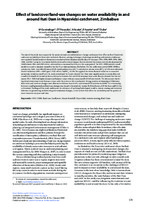| dc.contributor.author | Gumindoga, W. | |
| dc.contributor.author | Rwasoka, D.T. | |
| dc.contributor.author | Ncube, N. | |
| dc.contributor.author | Kaseke, E. | |
| dc.contributor.author | Dube, Timothy | |
| dc.date.accessioned | 2018-03-13T13:37:55Z | |
| dc.date.available | 2018-03-13T13:37:55Z | |
| dc.date.issued | 2018 | |
| dc.identifier.citation | Gumindoga, W. et al. (2018). Effect of landcover/land-use changes on water availability in and around Ruti Dam in Nyazvidzi catchment, Zimbabwe. Water SA, 44(1): 136 - 145 | en_US |
| dc.identifier.issn | 1816-7950 | |
| dc.identifier.uri | http://dx.doi.org/10.4314/wsa.v44i1.16 | |
| dc.identifier.uri | http://hdl.handle.net/10566/3577 | |
| dc.description.abstract | The aim of this study was to quantify the upstream land-use and landcover changes and assess their effect on Ruti Dam levels
and water availability in Nyazvidzi catchment. Remote-sensing techniques, hydrologic modelling and statistical inference
were applied. Spatial landcover dynamics were derived from Landsat satellite data for the years 1984, 1990, 1993, 1996, 2003,
2008, and 2013 using the maximum likelihood classification technique. Results showed that forests and shrubs decreased by
36% between 1984 and 2013 whilst cultivated areas increased by 13% over the same period. The HEC-HMS rainfall-runoff
model was used to simulate steamflow for the Nyazvidzi catchment, Zimbabwe. For the calibration period (2000–2001), a
satisfactory Nash–Sutcliffe efficiency (NSE) model peformance of 0.71 and relative volume error (RVE) of 10% were obtained.
Model validation (1995—1997) gave a NSE of 0.61 and RVE of 12%. We applied the Mann-Kendall trend test to assess for
monotonic trends in runoff over the study period and the results showed that there were significant decreases in observed
runoff at Station E140 (monthly time scale) and at Stations E62 and E140 (seasonal time scale). Results showed that the wet
season (Nov–Feb) had higher mean water balance values with an excess runoff of 8.12 mm/month. The dry season (April—
Sept) had lower mean water balance values, with the lowest at 0.04 mm/month. Strong positive relationships (r2) between
dam levels and land-use changes were obtained as follows: bare (0.95), cultivation (0.76) and forests (0.98). The relationship
between runoff generated and land-use changes was found to be relatively weaker (0.54 for forests, 0.51 for bare and 0.14 for
cultivation). Findings of this study underscore the relevance of applying hydrological models, remote sensing and statistical
inference in quantifying and detecting environmental changes, as well as how they affect the availability and the quality of
water resources in space and time. | en_US |
| dc.language.iso | en | en_US |
| dc.publisher | Water Research Commission | en_US |
| dc.rights | Published under a Creative Commons Attribution Licence | |
| dc.subject | HEC-HMS | en_US |
| dc.subject | Land-use | en_US |
| dc.subject | Landcover | en_US |
| dc.subject | Mann-Kendall | en_US |
| dc.subject | Nyazvidzi | en_US |
| dc.subject | Remote sensing | en_US |
| dc.subject | Ruti Dam | en_US |
| dc.title | Effect of landcover/land-use changes on water availability in and around Ruti Dam in Nyazvidzi catchment, Zimbabwe | en_US |
| dc.type | Article | en_US |
| dc.privacy.showsubmitter | FALSE | |
| dc.status.ispeerreviewed | TRUE | |

